Abstract
Urban spatial compactness is crucial for reducing carbon emissions and promoting sustainable urban development. However, the potential of and variations in spatial compactness in county-level carbon reduction have been largely overlooked. Taking the county-level areas in the Beijing–Tianjin–Hebei (BTH) region as an example, after reviewing the dimensions, scales, and pathways of the existing research, we quantifies the spatial compactness from 2005 to 2015 in terms of density, morphology, and function. The results reveal that, firstly, BTH county-level areas’ carbon emissions, both per land area (CO2/L) and per capita (CO2/P), have generally risen. Heterogeneity varied across spatial compactness indicators: urban density and functional compactness increased, while morphological compactness showed a minor fluctuation. Second, the correlations with CO2/L were stronger than those with CO2/P, ranking from urban density, functional compactness > morphological compactness. Additionally, the geographically and temporally weighted regression (GTWR) model revealed the spatial and temporal heterogeneity in the impact of spatial compactness on carbon emission intensity. The heterogeneity results provide insights into the mechanisms and general patterns of the differences in the factors influencing carbon emissions in four different types of county-level areas, namely, central, eastern, southern, and northwestern, offering policy guidance to promote the reductions in both CO2/L and CO2/P. This study is helpful for proposing urban spatial planning strategies for carbon reduction and formulating differentiated carbon reduction policies.
1. Introduction
Climate change is currently one of the greatest challenges to human development, and the international community has reached a consensus on reducing greenhouse gas emissions and implementing a low-carbon economy [1,2]. Cities, as areas where human activities have the greatest impact on the Earth’s surface, account for 75 percent of the world’s primary energy consumption and more than 80 percent of greenhouse gas emissions [3,4], and this proportion will continue to increase as the global urbanization process continues [5]. The way cities develop over the next decade will therefore have a critical impact on achieving carbon neutrality targets, and research into low-carbon urbanism has attracted widespread attention.
The rapid process of urbanization has not only reshaped the urban landscape but has also brought about significant changes in the urban morphological structure [6]. Urban form and structure are spatial reflections of urban development patterns, which can be harnessed to capture urban carbon emissions through energy flows, material cycles, and biological processes while generating spillover effects on the economy, society, and environment [7,8]. What kinds of urban form and structure are the most effective at reducing carbon emissions has been a major topic of academic debate. Inspired by urban scale theory and “New Urbanism” [9], more and more studies in the literature suggest that a sustainable low-carbon city model should have “compact: spatial characteristics [10].
The so-called compact city aims to curb urban sprawl through the development of high-density urban centers, optimize transport modes, increase the efficiency of infrastructure use, and reduce greenhouse gas emissions [11]. However, the issue of urban form is complex. The general view is that the more compact the city center, the better it is at reducing commuting distances and thus carbon emissions [12]. However, for some cities with small city centers, underdeveloped public transport, or already high central density, increasing the compactness of the city will only exacerbate traffic congestion and the urban heat island effect, and increase carbon emissions. It can be seen that it is still controversial whether compact urban spaces are low carbon emitters [13,14]. This led us to consider the following question: should different cities follow the same compact development pattern? For China, which is a vast country with large differences in the geographical environment and economic and social development among cities, the study of this issue is more relevant.
In recent years, under China’s “dual-carbon” target, urban spatial resource allocation and functional restructuring have become important ways to achieve carbon reduction through regulating urban forms. However, the existing research on urban spatial carbon reduction lacks an understanding of the influencing mechanisms through quantitative empirical exploration and the carbon reduction logic of spatial form regulation has not been explained, which hinders the effective integration of spatial planning systems and low-carbon technology. In addition, the individual variability in and laws influencing urban spatial carbon reduction are still unclear [15]. Therefore, by dissecting the correlation between urban spatial compactness and carbon emissions and studying the heterogeneity of carbon emissions’ impact in different cities, we can promote the optimal allocation of urban resources, the construction of urban spatial carbon reduction planning methodologies, and the formulation of differentiated carbon emission reduction policies, which is a key issue in promoting low-carbon development.
Based on this context, this study took the Beijing–Tianjin–Hebei (BTH) region as the research object and, by elaborating the dimensions, scales, and pathways of the impact of urban spatial compactness on carbon emissions, quantified spatial compactness from 2005 to 2015 using multisource data. This study also used an econometric model to analyze the correlation between urban spatial compactness and carbon emission intensity at the global level, and we explored the impact of urban spatial compactness indices based on the geographically and temporally weighted regression (GTWR) model. We modeled the spatial and temporal heterogeneity of urban spatial compactness indicators based on the GTWR model and finally proposed relevant carbon emission reduction policies for different regions from the perspective of spatial structure optimization to help urban planners better design low-carbon urban systems.
2. Literature Review
2.1. Dimensions and Scales of the Impact of Spatial Compactness on Carbon Emissions
In recent years, the relationship between urban compactness and carbon emissions has been studied from different perspectives. Initially, compact cities were proposed as a counterpart to low-density sprawling cities, and thus “density” became the most widely used perspective for measuring urban compactness [16]. More established studies have used density indicators such as population, buildings, and economic factors to assess the correlation between urban compactness and carbon emissions, demonstrating that land resources are most efficiently used in high-density rings where buildings are interconnected, road connectivity is high, and labor is concentrated [17]. However, density only reflects the average distribution of urban elements and cannot reflect the spatial agglomeration or distribution of these elements [18,19]. With the development of urban systemicity and networking, scholars have started to study urban land use morphology based on morphological dimensions, which provides an effective way to measure urban compactness. Nowadays, the measurement of urban land use morphology has become more mature, and indicators such as network dimension, shape index, and expansion index have been widely used to explore the relationship between urban compactness and carbon emissions, proving the difference and complexity of the impact of land use compactness on carbon emissions [20].
In terms of research scales, the study of the relationship between spatial compactness and carbon emissions has mainly covered three spatial scales: region, city, and neighborhood. At the regional level, the characteristics of the spatial structure of different urban agglomerations with respect to carbon emissions have been discussed, and it has been shown that a polycentric structure does not necessarily lead to a reduction in carbon emissions for all urban agglomerations. At the city scale, the impact of compactness on transport emissions, household carbon footprints, and environmental benefits has been explored, revealing differences between cities of different sizes [21,22]. On the other hand, it has revealed the enhancement in carbon emission efficiency achieved with the compactness of land use patterns, transport, and infrastructure [23], while researchers have attempted to formulate strategies for the development of compact cities, including the creation of multicenter networks, the improvement in city–suburb connections, and the promotion of mixed land use [24]. At the neighborhood scale, greater attention has been paid to the impact of specific land uses and building layout forms on the microclimate environment. In recent years, mixed land use, the control of development capacity, and the optimization of blue-green spaces have emerged as pivotal strategies for carbon reduction in neighborhoods [25,26].
Despite the considerable progress made by a large number of studies at different levels, it is clear that there are still shortcomings in the following areas: Firstly, there has been a greater emphasis on studies that examine “density” and “morphological: compactness indicators from geographical and morphological perspectives, while there has been a lack of studies from a functional perspective, such as the form of spatial layout of functional elements in the city, such as transport, commerce, and industry. This has ultimately led to an incomplete analysis of the drivers of carbon emissions. Secondly, the majority of extant studies have concentrated on the quantitative analysis of the relationship between carbon emissions and urban spatial patterns during the process of urbanization at the municipal scale. This has particularly been the case in megacities or developed cities, with little consideration given to the contribution of the spatial patterns of construction land in the central urban areas of counties. Furthermore, there have been few studies that have taken into account less-developed areas. As the basic spatial unit upon which China’s new urbanization and ecological management decisions are based, the county-level area is of great importance for the construction of regional ecological civilization and the development of green transformation. Its study is conducive to the effective implementation of energy conservation and emission reduction policies. In view of the above considerations, this study adopted the BTH urban agglomeration as the study area, with county-level areas designated as the typical study units. This research quantified urban spatial compactness in three dimensions: density, morphology, and function. Furthermore, a quantitative analysis was conducted to examine the general pattern of the impact of urban spatial compactness on carbon emissions.
2.2. Pathways of Spatial Compactness on the Impact of Carbon Emissions
It is only through a deep understanding of the relationship between urban spatial form and carbon emissions that we can truly and effectively explain the regional differences in the impact of spatial compactness on carbon emissions and implement urban spatial carbon reduction planning practices. Combined with a series of foundational studies in the field, the mechanisms and pathways through which urban spatial compactness affects carbon reduction have begun to emerge. The existing literature indicates that urban spatial form exerts its influence on carbon emissions via indirect pathways [27]. These indirect pathways operate through the intermediary effects of various factors, thereby promoting or inhibiting urban carbon emissions [28]. Research on the impact of urban spatial compactness on carbon emissions can be distilled into three key aspects: industrial, transport, and building carbon emissions (Figure 1).
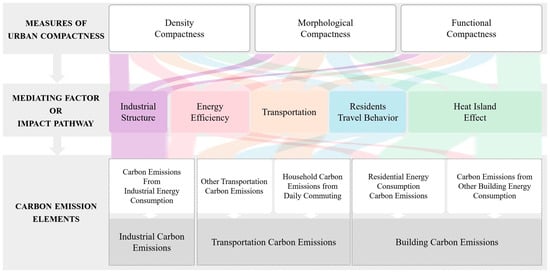
Figure 1.
Pathways through which spatial compactness affects carbon emissions.
Industrial carbon emissions are an important factor influencing urban carbon emissions. Urban industrial structure and energy efficiency are important factors through which spatial compactness affects industrial carbon emissions. Firstly, the expansion of the urban construction scale can attract capital investment, promote the upgrading of industrial structure, and reduce industrial carbon emissions; the expansion of the industrial land scale also leads to an increase in energy demand, which makes the total industrial carbon emissions increase [29]. Secondly, reasonable urban land use form and functional compactness can optimize industrial spatial layout, form overall coordinated industrial clusters, improve energy use efficiency and industrial park operation efficiency, and reduce unnecessary energy consumption in the industrial process [30].
Transport carbon emissions include carbon emissions from travel behavior, such as daily household commuting, as well as other transport carbon emissions in cities. The transport system and mode choice are important mediators of the spatial compactness pathway for transport carbon emissions [31]. Specifically, a compact mix of urban space can affect the transport system; a compact urban space has more concentrated transport demand, while a dispersed urban spatial structure has larger traffic flows, increasing the likelihood of increased carbon emissions [32]. Second, compact and functionally mixed land use affects individual carbon emissions from work and nonwork travel by shortening travel distances and altering the travel mode choices of residents [33].
Building carbon emissions include carbon emissions from residential energy consumption as well as carbon emissions from other building energy consumptions. Energy efficiency and the heat island effect are important intermediary factors affecting building carbon emissions. On the one hand, the agglomeration of the urban population, roads, and buildings favors centralized energy supply, which reduces energy losses in transport and improves the energy efficiency of buildings [34]. On the other hand, reasonable land use form and functional organization can create better urban ventilation corridors, promote air circulation in urban areas, reduce the urban heat island effect, and then reduce building carbon emissions [35]. However, an overly compact and dense urban land use pattern is prone to the heat island effect, leading to an increase in building energy consumption. In addition, a good blue-green spatial structure not only increases the carbon sink and sequestration capacity of a city but also mitigates the urban heat island effect and reduces carbon emissions due to building energy consumption [36].
Through a literature review, we found that urban spatial compactness mainly affects urban industrial, transport, and building carbon emissions through five mediating factors, namely, industrial structure, energy efficiency, transport, residents’ travel behavior, and the heat island effect, which laid the foundation for our later research on the mechanism of the impact of spatial compactness on carbon emission intensity. In addition, it can be seen that the current studies have reached mixed conclusions on the impact of spatial compactness on carbon emissions. Therefore, there is a need for more detailed heterogeneity studies by region and type.
3. Materials and Methods
3.1. Study Area and Data Sources
3.1.1. Study Area
Located in the heart of China’s Bohai Rim, the BTH urban agglomeration is the largest and most dynamic economic region in northern China and is known as the ‘Capital Economic Circle’. With a total area of about 218,000 square kilometers, it accounts for about 2.25 percent of China’s land area, and its population and GDP exceed 4 percent of the country’s total. As one of the regions with a high concentration of population, economy, consumption, and industry in China, rapid urbanization has brought about negative effects such as air pollution, and its average annual carbon emission is more than 1 billion tons, accounting for about 1/9th of the total national carbon emissions [37]. Therefore, identifying the main factors influencing carbon emissions in cities has become one of the most important research topics in recent years. This study breaks through the limitation of a single city and metropolitan area, taking the county-level areas of the BTH urban agglomeration as the study unit, covering 200 districts, counties, and county-level cities in 13 cities. Given the cross-border characteristics of urban construction land concentrated in the study area, in order to accurately measure the various agglomeration indices of construction land, this study combined the county units involved in construction land in the central city of each city. In the end, a total of 178 study units were obtained (Figure 2).
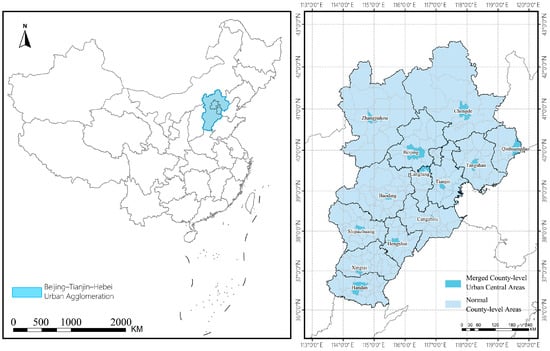
Figure 2.
Study area.
3.1.2. Data Sources
The data used in this study included carbon emission data, socioeconomic data, land use data, and POI data of BTH districts and counties in 2005, 2010, and 2015. Carbon emission data were obtained from the open source data published in the scientific data literature by Chen et al. [38]. To more accurately and objectively reflect the changes and regional differences in carbon emissions, this study used two carbon emission intensity indicators, namely, per land area carbon emissions (CO2/L) and per capita carbon emissions (CO2/P). Socioeconomic data were obtained from the 2005–2015 China County Statistical Yearbook, the statistical yearbooks of each city, and the government work reports of the districts and counties in the study area for some years. Land use data were obtained from the Resource and Environment Science and Data Centre of the Chinese Academy of Sciences (https://www.resdc.cn, accessed on 23 January 2023) with a resolution of 30 m. Point of interest (POI) data were obtained from the Gaode Map Open Platform.
3.2. Research Framework
This study aimed to improve our understanding of the relationship between spatial compactness and carbon emissions at the county level. There were three main questions in this study (Figure 3): (1) What are the spatial and temporal patterns of carbon emission intensity and spatial compactness? (2) What are the correlations between spatial compactness and carbon emission intensity? (3) How do the effects of spatial compactness on carbon emission intensity vary spatially and temporally? First, we quantified urban spatial compactness from three dimensions of “density–morphological–function” and analyzed the spatial and temporal patterns of carbon emission intensity and different compactness indicators. Second, we explored the influence of different spatial compactness indicators on carbon emission intensity at the global scale based on correlation analysis, and we revealed the correlation differences of different spatial compactness indicators. Finally, the GTWR model was used to analyze the spatial and temporal heterogeneity of the spatial compactness influencing carbon emissions, and the general pattern of the factors influencing carbon emissions was explored in depth by creating different regions, in order to provide a reference for differentiated spatial carbon emission reduction planning in BTH county-level areas.
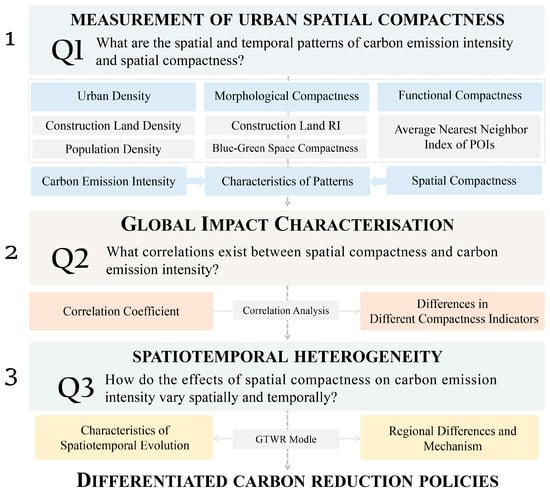
Figure 3.
Research framework.
3.3. Methods
3.3.1. Measurement of Spatial Compactness
Through the above literature review and the sorting of common indicators for measuring urban spatial compactness, the specific indicator selection and calculation methods in this study were as follows (Table 1).

Table 1.
Selection of spatial compactness indicators.
3.3.2. Correlation Analysis
Before analyzing the correlation between each spatial compactness index and carbon emission intensity, the data were first standardized for CO2/L, CO2/P, and five spatial compactness indicators of the three categories. Then, the ordinary least squares (OLS) model was used to conduct the multicollinearity test, and the results showed that the maximum value of the variance inflation factor (VIF) of the explanatory variables in the three years was less than 10, which means that there was no redundancy or multicollinearity problems among the explanatory variables. Then, the correlation analysis between the spatial compactness index and carbon emission intensity was carried out by using the Pearson analysis method with IBM SPSS Statistics 21 to analyze the change rule of the correlation coefficients between various types of compactness indices and carbon emissions. The Pearson correlation coefficients were graded as follows: complete linear correlation when |r| = 1; strong correlation when 0.7 ≤ |r| < 1; significant correlation when 0.5 ≤ |r| < 0.7; slightly weak correlation when 0.3 ≤ |r| < 0.5; weak correlation when |r| < 0.3; and no linear correlation when |r| = 0 [39].
3.3.3. GTWR Spatiotemporal Geographically Weighted Regression Model
BTH covers a large number of cities, and there are obvious differences in the development level and energy consumption structure of different cities, which lead to significant spatial heterogeneity in the urban carbon emissions among different regions. GTWR, as a new statistical method of exploring spatial differentiation, can effectively detect the spatial heterogeneity of elements, and, with the addition of a temporal dimension based on the GWR model, it could effectively deal with spatiotemporal nonstationarity [40] and better explain the spatial and temporal evolution of the effect of spatial compactness on carbon emissions. The expression of the GTWR model is as follows:
where (ui, vi, ti) denotes the spatiotemporal coordinates of the ith county cell; βk(ui, vi, ti)Xik denotes the kth regression parameter on the ith observation as a function of spatiotemporal location; and i denotes the residual term on the observation.
4. Results
4.1. Spatiotemporal Characteristics of Urban Carbon Emissions and Spatial Compactness
4.1.1. Characteristics of Spatiotemporal Patterns of Carbon Emissions
The results showed that there were large differences in carbon emission intensity between the counties of the BTH (Figure 4a–c). From 2005 to 2015, the CO2/L increased from 0.43 million tons/km2 in 2005 to 0.68 million tonnes/km2 in 2015. Except for individual units such as the Beijing central district, where the CO2/L decreased (Figure 5), the rest of the units rose year by year, reflecting the positive efforts and effectiveness of Beijing, as a first-tier city in China, in promoting green and low-carbon development, optimizing the industrial structure, and improving energy efficiency. The spatial distribution of CO2/L showed a two-tiered pattern of high in the east and low in the west, with high values concentrated in the central districts of Beijing, Tianjin, and Handan, with the highest value occurring in the central district of Shijiazhuang. Low values concentrated in the northwestern counties, with the lowest value occurring in Kangbao. Due to the limited natural conditions and strict environmental protection requirements, the expansion of construction land in the northwestern part of the country has been slow, making it difficult to carry out large-scale industrial activities.
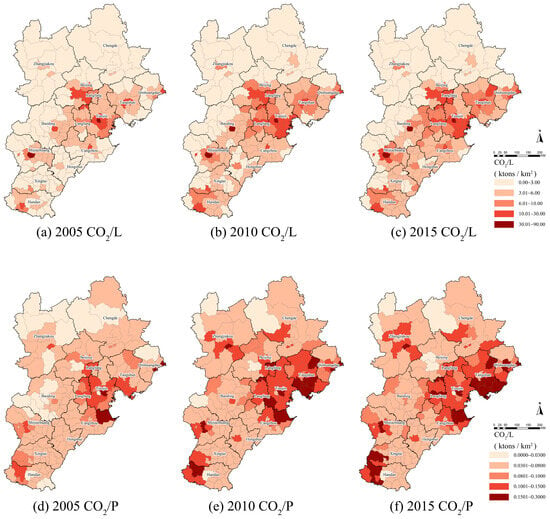
Figure 4.
Spatiotemporal patterns of carbon emission intensity, 2005–2015: (a) 2005 CO2/L; (b) 2010 CO2/L; (c) 2015 CO2/L; (d) 2005 CO2/P; (e) 2010 CO2/P; (f) 2015 CO2/P.
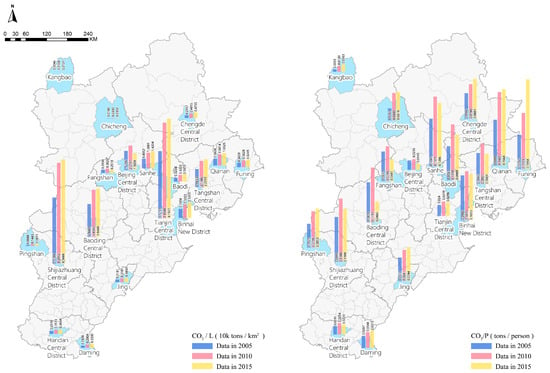
Figure 5.
Changes in carbon emission intensity of a typical unit, 2005–2010.
Between 2005 and 2015, the average CO2/P in BTH country-level areas increased from 0.06 tonnes per person in 2005 to 0.08 tonnes per person in 2015 (Figure 4d–f). Most of the more economically developed and densely populated central districts had a decreasing trend in CO2/P from 2010 to 2015. The overall CO2/P showed a bilevel spatial distribution characterized by high values in the east and low values in the west. Unlike the CO2/L, the high values of CO2/P concentrated in eastern Qinhuangdao, Cangzhou, Tianjin, and some southern units, while the low values were distributed in the central and northern units. It is worth noting that many regions had opposite rankings of CO2/L and CO2/P. The central district of Tianjin and the central district of Beijing, which had a higher CO2/L, had a lower CO2/P; the central district of Chengde, Pingshan, Sanhe, and Qian’an had a low CO2/L and high CO2/P (Figure 5).
4.1.2. Characteristics of Spatiotemporal Patterns of Spatial Compactness
By calculating the spatial compactness indicators for each county-level unit in the study area, the results were graded using natural breaks:
(1) Construction land density (Figure 6a): The results showed that the construction land density land in the county-level areas increased continuously from 2005 to 2015. The high compactness of construction land areas remained concentrated in the central district units, such as Beijing, Tianjin, and Shijiazhuang.

Figure 6.
Spatiotemporal patterns of spatial compactness indicators, 2005–2010. (a) Construction land density. (b) Population density. (c) Construction land RI. (d) Blue-green space compactness. (e) Functional compactness.
(2) Population density (Figure 6b): The results of the population density calculations indicated that most of the county-level areas in the BTH fell into the low-compactness population category. The population density increased during the 2005–2015 period, forming a high compactness of population in the sprawling agglomeration belt along the core region of Tianjin–Beijing–Baoding–Shijiazhuang–Handan.
(3) Construction land RI (Figure 6c): The construction land RI calculation results showed that the RI for the majority of the county-level areas in the BTH decreased to varying degrees from 2005 to 2010. This indicated a weakening of the aggregation of urban construction land during that period. From 2010 to 2015, the overall changes in compactness were minimal, suggesting a stabilization in the spatial development of urban construction land.
(4) Blue-green space compactness (Figure 6d): The spatial layout of blue-green space compactness in BTH was relatively stable from 2005 to 2015, with a belt-shaped distribution. Areas with high compactness of blue-green space were concentrated in the northwestern regions, such as Chengde and Zhangjiakou to Baoding, while areas with low blue-green space compactness were found in the eastern urban belt from Handan to Tangshan. This reflected the ecological imbalance within the BTH region.
(5) Functional compactness (Figure 6e): As shown in the calculation results of the functional compactness indicator, the functional compactness of BTH increased from 2005 to 2015, reflecting the increasing concentration of urban functions driven by the urbanization process. In 2005, areas with high functional compactness included Beijing, Tianjin, and some individual city districts. By 2015, this high functional compactness had expanded to include contiguous areas such as Beijing, Tianjin, Shijiazhuang, Cangzhou, and Tangshan. Meanwhile, the spatial extent of low functional compactness gradually narrowed and, by 2015, was concentrated in the north, particularly in Chengde and Zhangjiakou.
4.2. Global Impact of Spatial Compactness on Urban Carbon Emissions
According to the results of the two-way correlation analysis between urban spatial compactness and carbon emission intensity (Table 2), it is evident that the direction and strength of the influence of various spatial compactness variables on carbon emission intensity differed. There was also a notable difference between the influences on CO2/L and CO2/P. For CO2/L, spatial compactness exhibited a strong influence, ranked as follows: urban density > functional compactness > morphological compactness. In contrast, the overall influence on CO2/P was weak. Specific analyses revealed that the construction land density and population density were positively correlated with both CO2/L and CO2/P. This indicated that the rapid urbanization and increasing population density in the BTH in recent years have contributed to higher urban carbon emission intensity. The negative correlation between the construction land RI and carbon emission intensity has been widely confirmed in previous studies [41,42]. A more compact urban construction land structure improves transport and energy use efficiency, thereby reducing carbon emissions. Additionally, blue-green space compactness negatively correlated with CO2/L, suggesting that urbanization disrupted blue-green space connectivity, reduced the effectiveness of carbon sinks, and led to higher carbon emissions. Functional compactness negatively correlated with both CO2/L and CO2/P, indicating that a rationally concentrated functional layout enhanced land use efficiency at the county level. Overall, spatial form regulation and carbon reduction strategies in BTH county-level areas should focus on limiting the expansion of construction land and the population scale, while promoting low-carbon and sustainable economic and social development through the clustering of morphology and functions.

Table 2.
Results of correlation analysis between spatial compactness and carbon emission intensity.
4.3. Spatiotemporal Heterogeneity Analysis Based on GTWR
4.3.1. Estimation Results of GTWR Model
The regression results of the GTWR are shown in Table 3. It can be seen that the R2 and adjusted R2 of the two models are 0.96, 0.96 and 0.75, 0.74, respectively, indicating that the models were well fitted. The regression coefficients of each spatial compactness indicator with CO2/L and CO2/P were evaluated with ArcGIS10.5 software using the natural breakpoint method. When the regression coefficient was positive, the independent variable had a positive influence on the carbon emission intensity, which was classified into strong positive influence, medium positive influence, and weak positive influence according to the influence from strong to weak. If the regression coefficient was negative, the independent variable had a negative influence on the urban carbon emission intensity, which was classified as strong negative influence, medium negative influence, and weak negative influence in order of strength.

Table 3.
Regression coefficients of the GTWR results.
4.3.2. Heterogeneity in the Effect of Spatial Compactness on Carbon Emissions
Figure 7 shows the characteristics of the impact of each spatial compactness indicator on CO2/L and CO2/P in 2005, 2010, and 2015, revealing the obvious spatial and temporal heterogeneity of the impact of spatial compactness on carbon emission intensity. Over time, the contribution coefficient of spatial compactness to the carbon emission intensity of the same regional unit showed obvious positive and negative changes. In this case, the positive range of influence indicated that increased spatial compactness was associated with an increase in carbon emission intensity, while the negative area of influence indicated that increased spatial compactness was associated with a decrease in carbon emission intensity.
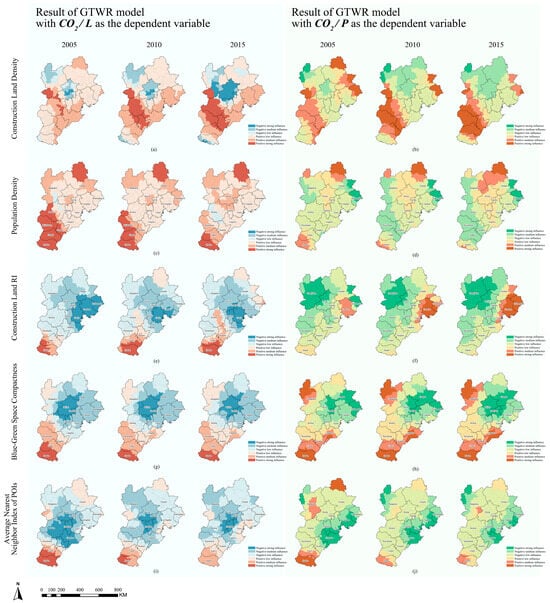
Figure 7.
Spatiotemporal distribution of the impact of spatial compactness on carbon emission intensity. (a,b) The distribution of coefficients of construction land density. (c,d) The distribution of coefficients of population density. (e,f) The distribution of coefficients of construction land RI. (g,h) The distribution of coefficients of blue-green space compactness. (i,j) The distribution of coefficients of functional compactness.
(1) Construction land density (Figure 7a,b): From 2005 to 2015, the negative influence area of construction land density on carbon emissions in the BTH county-level areas has increased, especially in the central Beijing district and its surrounding areas. In the southern region, the area of strong positive influence has been concentrated and expanded.
(2) Population density (Figure 7c,d): As shown in Figure 7c, population density had an obvious positive effect on CO2/L in most of the BTH county-level areas, and the area of strong positive influence gradually shrank from 2005 to 2015. As shown in Figure 7d, population density had both positive and negative effects on CO2/P, and the area of positive influence in the center and north was increasing, extending from Chengde in the north to Langfang and Cangzhou in the south.
(3) Construction land RI (Figure 7e,f): As can be seen from Figure 7e, the positive and strong influence area of CO2/L was increasing in the south from 2005 to 2015, while the strong negative influence area concentrated in the eastern coastal region. Figure 7f shows that the strong positive influence area of CO2/P was increasing in the eastern region, while the strong negative influence area concentrated in the northwestern region.
(4) Blue-green space compactness (Figure 7g,h): From 2005 to 2015, the influence of blue-green space compactness on carbon emission intensity in BTH showed both positive and negative effects, with a relatively stable spatial distribution. The negative influence concentrated in the center and east, where the area with a strong negative influence of CO2/L remained in Beijing throughout the ten years. In contrast, the strong positive influence area of CO2/L was located in the south, while the strong positive influence area of CO2/P extended to both the south and the northwest regions.
(5) Functional compactness (Figure 7i,j): It can be seen that, except for the southern region, functional compactness had a negative impact on CO2/L and CO2/P in most county units in the BTH in 2005–2015, and the range of strong influence was shrinking significantly. In the southern region, the range of strong positive influence was shrinking.
5. Discussion
5.1. Analysis of Regional Differences and Mechanisms of the Impact of Spatial Compactness on Carbon Emissions
In the “Beijing–Tianjin–Hebei Integration and Coordinated Development Plan”, China’s Development and Reform Commission divides the functional zoning of BTH cities and towns into four parts: the central part (optimization and adjustment zone), the eastern part (coastal port industrial development zone), the southern part (manufacturing and agricultural zone), and the northwestern part (ecological protection and eco-industrial development zone). The central region includes Beijing and parts of Baoding, Langfang, and Tianjin; the eastern region includes coastal Qinhuangdao, Tangshan, Tianjin, and parts of Cangzhou; the southern region includes Handan, Xingtai, Shijiazhuang, Hengshui, and parts of Baoding; and the northwestern region includes parts of Zhangjiakou and Chengde (Figure 8). Based on the results of the spatial differentiation analysis of the impact of carbon emissions in Section 4.3.2, in combination with the functional zoning of BTH, the regional differences and mechanisms of the impact of urban spatial compactness on carbon emissions were further elucidated. In order to clearly illustrate the regional differences and patterns, this section presents the median scatter plot of the coefficients relating spatial compactness to carbon emission intensity, together with the frequency distribution curve of the points in the county-level areas in each region.
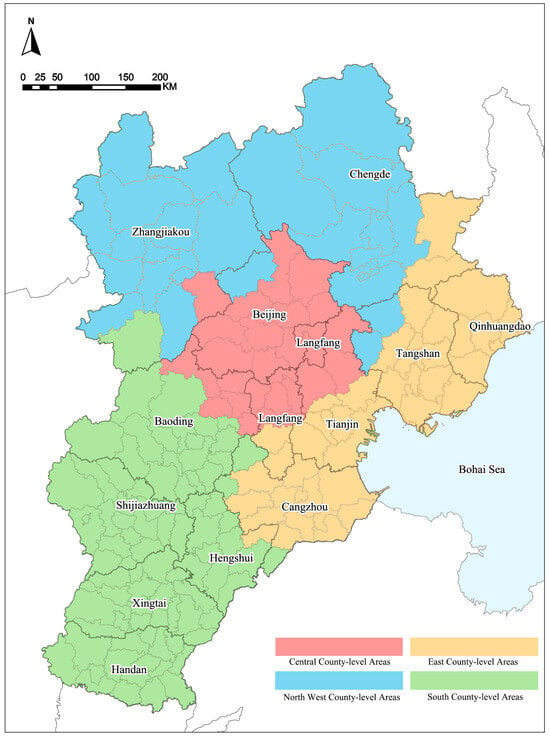
Figure 8.
BTH urban agglomeration county-level area divisions.
(1) Construction land density: Figure 9 shows the scatter distribution of the coefficients and the frequency distribution of construction land density in 2015. It can be seen that the central county-level areas around Beijing were mostly located in the third quadrant, and the construction land density negatively correlated with CO2/L and CO2/P, indicating that the region had a higher level of urbanization and industrialization, more intensive and efficient land use, a better industrial structure, and a more mature transport system; therefore, an increase in the construction land density brought about a decrease in carbon emission intensity. The eastern county-level areas were mostly located in the fourth quadrant, where the construction land density negatively correlated with CO2/P but positively correlated with CO2/L. The construction of these units should continue to optimize the internal space and improve the transport system and energy efficiency. Most of the points in the south were located in quadrant one, and the construction land density positively correlated with CO2/L and CO2/P. These county-level areas relied on land finance, and the crude development mode of blindly increasing the construction land scale will lead to the unneeded spread of construction land, which will consume a large amount of energy while increasing industrial activities, imposing a heavier burden on the environment and increasing carbon emissions from industry, transport, and buildings. In the northwestern county-level areas, which were located in the third and fourth quadrants, increasing the construction land density reduced the CO2/P, because the northwestern mountainous regions were sparsely populated, and the expansion of construction land further improved the efficiency of public transport and energy use in the cities.
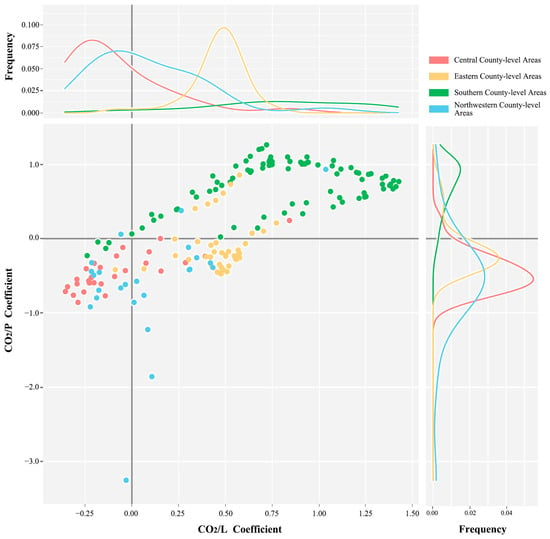
Figure 9.
Construction land density coefficient in 2015.
(2) Population density: Figure 10 shows the scatter distribution of the coefficients and the frequency distribution map of the population density in 2015. Population density positively correlated with CO2/L and CO2/P in the central county-level points, especially in central Beijing, where excessive population concentration has led to problems such as traffic congestion, the heat island effect, and the growth in energy consumption. The eastern county-level areas were concentrated in the fourth quadrant, and population concentration significantly positively correlated with CO2/L. This is because population concentration increased the pressure on per land area transport and building carbon emissions but had little effect on CO2/P. For the southern counties, where most points were located in quadrant four, an increase in population density reduced the CO2/P, suggesting that there was a waste of transport infrastructure and building energy in the operation of the city. For the northwestern county-level areas, population density and CO2/L positively correlated at all points, and the region was ecologically sensitive, with population growth causing some land use problems.
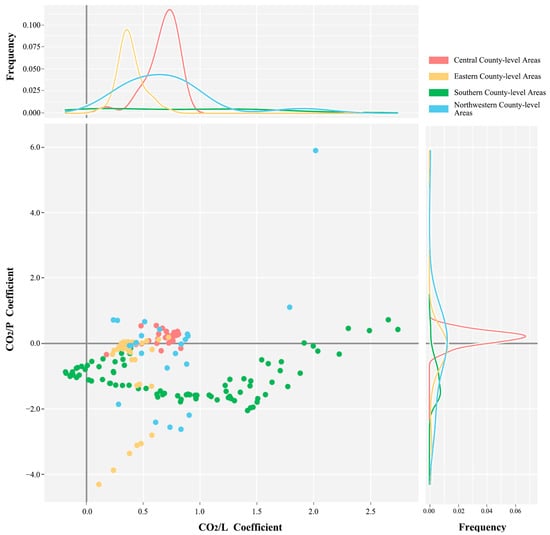
Figure 10.
Population density coefficient in 2015.
(3) Construction Land RI: Figure 11 shows the scatter distribution of coefficients and the frequency distribution map of construction land RI in 2015. The compactness of urban construction land represents the degree of regularity of the parcel edge; in general, the lower the urban construction land compactness, the higher the complexity, the more irregular the urban landscape, and the higher the urban carbon emissions [43]. It can be seen that the central and northwestern county-level areas were concentrated in the third quadrant, and the construction land RI negatively correlated with CO2/L and CO2/P. For these areas, a more regular construction land form can shorten the commuting distance, improve the efficiency of traffic and energy transport, and reduce the intensity of carbon emissions. In the eastern county-level areas, which were mostly located in the second and third quadrants, more compact construction land forms will reduce CO2/L but increase CO2/P in some counties, so it is necessary to promote low-carbon travel and lifestyles. In the south, where most of the county-level areas were located in the fourth quadrant, the clustering of construction land uses improved transport efficiency and reduced the CO2/P, but at the same time the compactness of land uses in some counties created a heat island effect and increased the CO2/L.
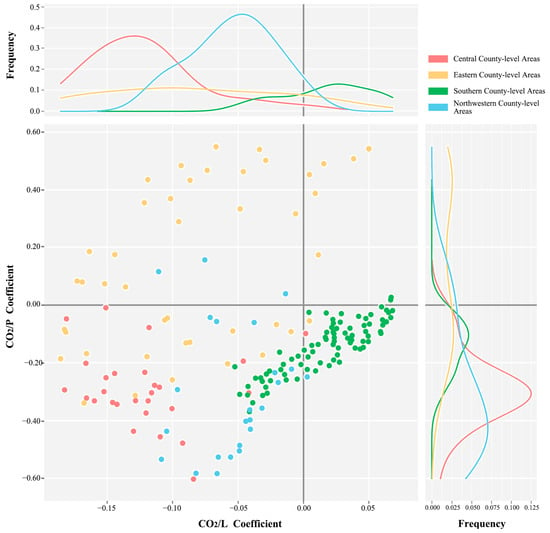
Figure 11.
Construction land RI coefficient in 2015.
(4) Blue-green space compactness: Figure 12 shows the scatter distribution of coefficients and the frequency distribution map of blue-green space compactness in 2015. The coefficients are mainly distributed in two quadrants. Blue-green space compactness can reflect the degree of fragmentation of urban ecological space; the higher the compactness, the higher the ecological spatial connectivity, the larger the scale of carbon sinks, and the positive impact on carbon storage. In the southern part, the points concentrated in the first quadrant, and there was a strong positive correlation between blue-green space compactness and carbon emission intensity, indicating that the concentrated and contiguous blue-green space provided space for the expansion of the construction land, resulting in increased carbon emissions. The central and eastern county-level areas mostly located in the third quadrant, and the blue-green space compactness negatively correlated with carbon emission intensity, which was due to the destruction of carbon sinks by urbanization in the region, so it is crucial to strengthen the development and protection of national land space and increase the connectivity of blue-green space. For the northwestern county-level areas, there was a negative correlation between blue-green spatial compactness and CO2/L, suggesting that further conservation of ecological space creates more carbon sinks.
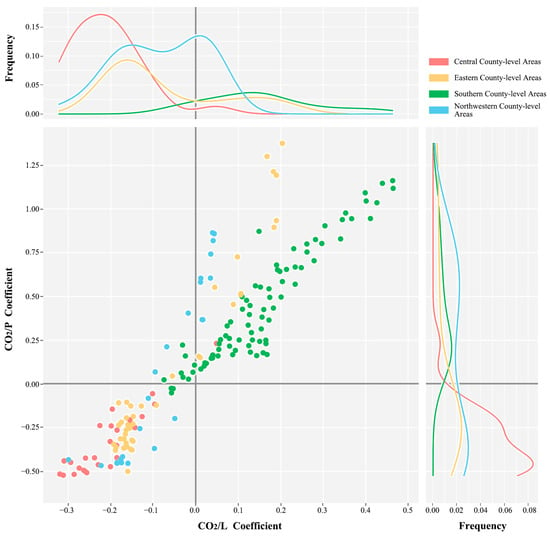
Figure 12.
Blue-green space compactness coefficient in 2015.
(5) Functional compactness: Figure 13 shows the scatter distribution of coefficients and the frequency distribution map of functional compactness in 2015. The central and northwestern points mostly located in the third quadrant, where functional compactness negatively correlated with CO2/L and CO2/P, suggesting that the clustering of urban functional space improved transport and energy efficiency. The southern county-level areas were located in the first, third, and fourth quadrants, and the functional compactness positively correlated with CO2/L and negatively correlated with CO2/P, indicating that the agglomeration of urban functional space in the southern region has caused some urban structural disturbances, leading to problems with energy, transport, and the heat island effect. The points in the east were distributed in the third and fourth quadrants, and it can be seen that the increase in functional compactness had a strong negative correlation with CO2/P, which shows that the agglomeration of functional space optimizes people’s travel modes and improves the balance of urban occupations and residences.
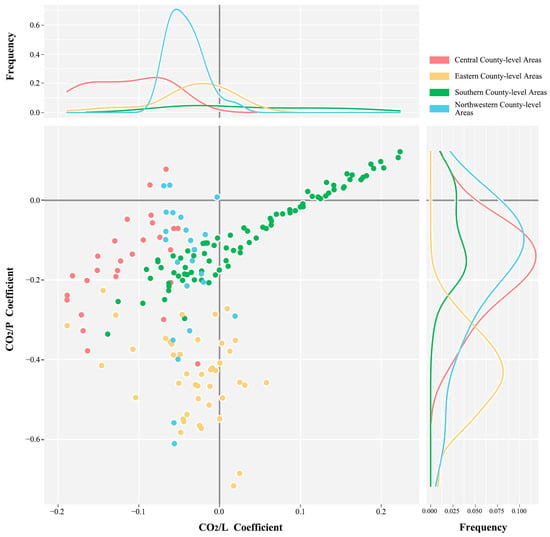
Figure 13.
Functional compactness coefficient in 2015.
5.2. Carbon Emission Reduction Policy Recommendations
In China, county-level areas often represent the industrial structure and economic direction of prefecture-level cities. Based on the above analyses of the differences in the impacts and mechanisms of carbon emissions in different regions of the BTH, we summarize the factors and general patterns of carbon emissions in different types of counties (Figure 14) and make policy recommendations to achieve reductions in both CO2/L and CO2/P in the BTH.
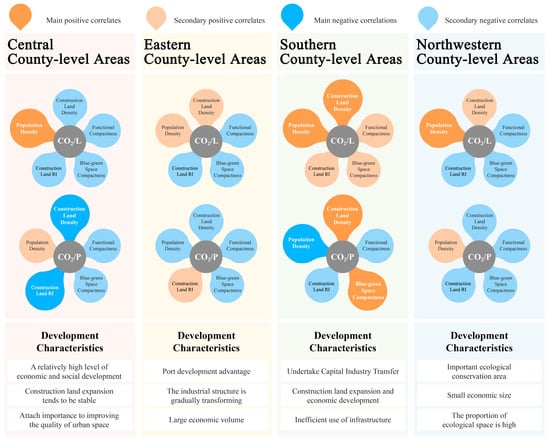
Figure 14.
General pattern of spatial compactness affecting carbon emissions in BTH at county level.
(1) Central county-level areas: Regarding the economically developed and well-structured central county-level areas, most of the units around Beijing have a high level of urbanization and industrialization, and the expansion of construction land has reached a stable stage. Beijing, in particular, has become more maturely urbanized. It was found that the agglomeration of construction land scale, construction land form, blue-green space and urban functions all contribute to carbon emission efficiency, but further population agglomeration will lead to more environmental and infrastructure burdens. Therefore, the county-level areas in this region should gradually ease urban functions in cooperation with neighboring small towns and cities, with conditions to alleviate overcrowding and optimize the spatial configuration of the city; at the same time, it should further rationalize the planning of public transport routes and appropriately control the density of urban roads on the basis of ensuring the accessibility of infrastructure, so as to reduce the demand for motor vehicles by urban residents.
(2) Eastern county-level areas: The eastern county-level area is the Bohai Bay urban belt, which has an inherent port advantage, including the Binhai New Area, which is an emerging heavyweight economic growth pole that China has built in recent years. In this region, the compactness of blue-green space and the urban functions have a reducing effect on the carbon emission intensity of the county-level areas, but the agglomeration of the construction land scale, construction land form, and population all have a promoting effect on carbon emission intensity. Further concentration of land and population should be controlled, and land use efficiency should be improved through the shaping of urban land use patterns and adjusting functional structures to achieve sustainable economic and social development. In addition, in order to avoid the heat island effect and traffic congestion caused by urban agglomeration, the lifestyle of residents should be improved, low-carbon awareness should be raised, and the construction of low-carbon transport facilities should be promoted.
(3) Southern county-level areas: For the southern county-level areas with a lagging industrial structure and inefficient land use, the economic development is still based on the expansion of construction land, and it has received a large number of heavy industrial transfers from capital following the “Beijing–Tianjin–Hebei integration” policy. In addition, the high population density in the region and the inefficient use of transport, industry, and infrastructure have increased the intensity of carbon emissions. It can be seen that all spatial compactness contributes to carbon emission intensity, especially the density of construction land. Therefore, the further agglomeration of urban scale, form, and function should be continuously controlled, its abundant human and natural resources should be reasonably used, and a scientific industrial cooperation system of division of labor should be further formed to improve the efficiency of input and output, so as to reduce excessive energy consumption. In terms of urban construction, the organic layout should be moderately decentralized to promote efficient use at various levels of scale. At the same time, blue and green spaces should be seamlessly formed within construction sites to increase urban carbon sinks.
(4) Northwestern county-level areas: The northwestern county-level areas have a low urbanization rate and economic volume and a good ecological foundation, making them important ecological conservation areas in north China. The high standard of ecological environmental protection has led to some restrictions on industrial development in the region, thereby reducing industrial carbon emissions. It can be seen that the compactness of construction land form, blue-green space, and urban function can reduce carbon emission intensity, while the scale of construction land and population compactness are the main factors that increase carbon emission intensity. The scale of construction land should be controlled, and the sustainable development of the city should be sought by improving the efficiency of transport and energy use through the agglomeration and regularization of construction land patterns and the centralized distribution of urban functions while maintaining an excellent ecological environment.
5.3. Limitations and Prospects of This Research
Throughout the existing studies on the relationship between urban spatial compactness and carbon emissions, several key questions have emerged: How should urban spatial compactness be measured? Are urban carbon emissions affected by urban spatial compactness? Through what channels does urban spatial compactness affect carbon emissions? What level of compactness is most effective in reducing carbon emissions? To address these questions, scholars have conducted numerous empirical analyses, gradually forming a quantitative research paradigm of “indicator measurement–correlation analysis–influence mechanism analysis–policy recommendation”. In the future, while maintaining this basic analytical framework, three areas can be further explored. First, there is a need to enrich the connotation of the urban spatial compactness indicator measurement. With the increasing accessibility of multisource data and advances in geospatial visualization and analysis technology, three-dimensional aspects can be integrated into the quantitative indicator system. This will support a more in-depth exploration of the factors influencing carbon emissions. Second, it is essential to analyze the interactions of factors influencing carbon emissions at multiple scales (hierarchical transmission). Future research can focus on the interactions of carbon emission factors at the “region–city–neighborhood” levels and explore analytical methods that can take into account the interplay of different mechanisms at different spatial scales. Thirdly, research should be conducted on the classification of cities and neighborhoods based on variations in carbon emission impact factors. Previous evidence suggests that differences in geographic environments and developmental stages can lead to inconsistent conclusions. Shifting from typical city studies to classification studies may better inform the formulation of differentiated spatial carbon mitigation strategies.
6. Conclusions
Due to the differences in geographical location, economic development, and built environment of the counties in the BTH urban agglomeration, the characteristics of spatial compactness change over time, and the carbon abatement methods in different regions are quite different. Therefore, this study focused on analyzing the spatial and temporal heterogeneity of the impact of spatial compactness on carbon emission intensity at the county level and proposed a pathway to achieve reductions in both CO2/L and CO2/P. The main conclusions are as follows:
- (1)
- According to the results of the spatial distribution map, from 2005 to 2015, the BTH CO2/L and CO2/P showed an overall upward trend, with individual units decreasing, and spatially showed a bipolar distribution pattern of high in the east and low in the west. The BTH spatial compactness in county-level areas had obvious characteristics of spatial differentiation. From 2005 to 2015, urban density and functional compactness increased, while morphological compactness remained stable.
- (2)
- According to the results of the correlation analysis, the different spatial compactness variables had different directions and strengths of influence on carbon emission intensity. Specifically, the correlations with CO2/L were stronger than those with CO2/P, ranking as urban density, functional compactness > morphological compactness. Overall, BTH county-level areas should focus on achieving spatial pattern regulation, carbon reduction, and sustainable economic and social development through morphological and functional agglomeration.
- (3)
- According to the coefficients of spatial compactness and carbon emission intensity calculated with the GTWR model, the influence of spatial compactness on carbon emission intensity had obvious spatiotemporal heterogeneity. The coefficients of the contribution of spatial compactness to carbon emission intensity of the same regional unit showed obvious positive and negative changes in the period of 2005–2015.
- (4)
- Based on the results of the analysis of regional differences and general patterns, the study area was divided into four areas: central, southern, eastern, and northwestern areas. Among them, for the economically developed and well-structured central county-level areas, the agglomeration of the construction land scale, construction land form, blue-green space, and urban functions can reduce the carbon emission intensity, but further agglomeration of the population will increase the carbon emission intensity. For the eastern county-level areas with coastal development and industrial transformation, the compactness of blue-green space and urban functions can reduce carbon emission intensity, but the agglomeration of the construction land scale, construction land form, and population can promote carbon emission intensity. For the southern county-level areas with a lagging industrial structure and inefficient land use, all spatial compactness contributes to carbon emission intensity, especially construction land density. For the northwestern county-level areas with excellent ecology and low construction intensity, the construction land form, blue-green space, and urban function can reduce the carbon emission intensity, while the compactness of construction land scale and population are the main factors increasing carbon emission intensity. In turn, differentiated carbon reduction policy recommendations can be made for county-level areas in different regions.
Author Contributions
M.L., conceptualization, methodology, software, formal data analysis, data curation, writing, initial draft preparation, and project administration; T.C., supervision and project administration; M.Z. and S.C., validation and interpretation of results; S.T. and J.L., reviewing and editing of the manuscript. All authors have read and agreed to the published version of the manuscript.
Funding
This research was funded by the National Natural Science Foundation of China (NSFC), Grant agreement ID 52378066. Natural Science Foundation of Ningxia Province, grant agreement ID 2024AAC03071.
Data Availability Statement
All supporting data are cited within Section 3 Materials and Methods.
Conflicts of Interest
The authors declare no conflicts of interest.
References
- United Nations Framework Convention on Climate Change. Paris Agreement. 12 December 2015. Available online: https://unfccc.int/sites/default/files/resource/parisagreement_publication.pdf (accessed on 1 October 2024).
- Yinta, Z. Low Carbon Economy and Low Carbon City. Urban Stud. 2008, 15, 98–102. [Google Scholar]
- Yu, X.; Wu, Z.; Zheng, H.; Li, M.; Tan, T. How urban agglomeration improve the emission efficiency? A spatial econometric analysis of the Yangtze River Delta urban agglomeration in China. J. Environ. Manag. 2020, 260, 110061. [Google Scholar] [CrossRef] [PubMed]
- UN-Habitat. Urbanization and Development Emerging Futures World Cities Report; United Nations Human Settlements Programme: New York, NY, USA, 2016. [Google Scholar]
- Wang, Y.; Zhang, X.; Kubota, J.; Zhu, X.; Lu, G. A semi-parametric panel data analysis on the urbanization-carbon emissions nexus for OECD countries. Renew. Sustain. Energy Rev. 2015, 48, 704–709. [Google Scholar] [CrossRef]
- Kai, Y.; Xin, Y. The impact of urban compactness on urban carbon emissions: A study of 281 Chinese cities. Urban Clim. 2024, 56, 102052. [Google Scholar]
- Wang, Y.; Niu, Y.; Li, M.; Yu, Q.; Chen, W. Spatial structure and carbon emission of urban agglomerations: Spatiotemporal characteristics and driving forces. Sustain. Cities Soc. 2022, 78, 103600. [Google Scholar] [CrossRef]
- Zhu, Y.; Hu, Y. The Correlation between Urban Form and Carbon Emissions: A Bibliometric and Literature Review. Sustainability 2023, 15, 13439. [Google Scholar] [CrossRef]
- Bettencourt, L.; Lobo, J.; Helbing, D.; Kühnert, C.; West, G. Growth, innovation, scaling, and the pace of life in cities. Proc. Natl. Acad. Sci. USA 2007, 104, 7301–7306. [Google Scholar] [CrossRef]
- Ting, S. Study on spatial form compactness from low-carbon perspective. Geogr. Res. 2013, 32, 1057–1067. [Google Scholar]
- Dantzig, G.B.; Satty, T.L. Compact City: A Plan for a Liveable Urban Environment; Freeman and Company: San Francisco, CA, USA, 1973. [Google Scholar]
- Cirilli, A.; Veneri, P. Spatial Structure and Carbon Dioxide (CO2) Emissions Due to Commuting: An Analysis of Italian Urban Areas. Reg. Stud. 2014, 48, 1993–2005. [Google Scholar] [CrossRef]
- Xu, X.; Ou, J.; Liu, P.; Liu, X.; Zhang, H. Investigating the impacts of three-dimensional spatial structures on CO2 emissions at the urban scale. Sci. Total Environ. 2020, 762, 143096. [Google Scholar] [CrossRef]
- Hong, S.F.; Hui, E.C.M.; Lin, Y.Y. Relationship between urban spatial structure and carbon emissions: A literature review. Ecol. Indic. 2022, 144, 109456. [Google Scholar] [CrossRef]
- Li, J.; Huang, X.; Chuai, X.; Yang, H. The impact of land urbanization on carbon dioxide emissions in the Yangtze River Delta, China: A multiscale perspective. Cities 2021, 116, 103275. [Google Scholar] [CrossRef]
- Rahman, M.; Islam, M.; Neema, M. GIS-based compactness measurement of urban form at neighborhood scale: The case of Dhaka, Bangladesh. J. Urban Manag. 2022, 11, 6–22. [Google Scholar] [CrossRef]
- Gerritse, M.; Arribas-Bel, D. Concrete agglomeration benefits: Do roads improve urban connections or just attract more people? Reg. Stud. 2018, 52, 1134–1149. [Google Scholar] [CrossRef]
- Pafka, E. Multi-scalar urban densities: From the metropolitan to the street level. Urban Des. Int. 2020, 27, 53–63. [Google Scholar] [CrossRef]
- Yang, J.; Li, S.; Lu, H. Quantitative Influence of Land-Use Changes and Urban Expansion Intensity on Landscape Pattern in Qingdao, China: Implications for Urban Sustainability. Sustainability 2019, 11, 6174. [Google Scholar] [CrossRef]
- Makido, Y.; Dhakal, S.; Yamagata, Y. Relationship between urban form and CO2 emissions: Evidence from fifty Japanese cities. Urban Clim. 2012, 2, 55–67. [Google Scholar] [CrossRef]
- Gaigné, C.; Riou, S.; Thisse, J.-F. Are compact cities environmentally friendly? Environ. Econ. 2012, 72, 123–136. [Google Scholar] [CrossRef]
- Thé, C.; Carantino, B.; Lafourcade, M. The Carbon ‘Carprint’ of Suburbanization: New Evidence from French Cities. Reg. Sci. Urban Econ. 2021, 89, 103693. [Google Scholar]
- Zhang, R.; Matsushima, K.; Kobayashi, K. Can land use planning help mitigate transport-related carbon emissions? A case of Changzhou. Land Use Policy 2017, 74, 32–40. [Google Scholar] [CrossRef]
- Fei, C.; Yonghe, L.; Xiaoqing, M. Is the city low-carbon because of its compactness? An empirical study in Shanghai, China. Urban Clim. 2023, 52, 101690. [Google Scholar]
- Lin, J.; Lu, S.; He, X.; Wang, F. Analyzing the impact of three-dimensional building structure on CO2 emissions based on random forest regression. Energy 2021, 236, 121502. [Google Scholar] [CrossRef]
- Leibowicz, B.D. Effects of urban land-use regulations on greenhouse gas emissions. Cities 2017, 70, 135–152. [Google Scholar] [CrossRef]
- Zhang, H.; Peng, J.; Wang, R.; Zhang, J.; Yu, D. Spatial planning factors that influence CO2 emissions: A systematic literature review. Urban Clim. 2021, 36, 100809. [Google Scholar] [CrossRef]
- Liu, S.; Shen, J.; Liu, G.; Wu, Y.; Shi, K. Exploring the effect of urban spatial development pattern on carbon dioxide emissions in China: A socioeconomic density distribution approach based on remotely sensed nighttime light data. Comput. Environ. Urban Syst. 2022, 96, 101847. [Google Scholar] [CrossRef]
- Xie, H.; Zhai, Q.; Wang, W.; Yu, J.; Lu, F.; Chen, Q. Does intensive land use promote a reduction in carbon emissions? Evidence from the Chinese industrial sector. Resour. Conserv. Recycl. 2018, 137, 167–176. [Google Scholar] [CrossRef]
- Liu, J.; Hou, X.; Wang, Z.; Shen, Y. Study the effect of industrial structure optimization on urban land-use efficiency in China. Land Use Policy 2021, 105, 105390. [Google Scholar] [CrossRef]
- Vandeweghe, J.R.; Kennedy, C. A Spatial Analysis of Residential Greenhouse Gas Emissions in the Toronto Census Metropolitan Area. J. Ind. Ecol. 2007, 11, 133–144. [Google Scholar] [CrossRef]
- Zahabi, S.; Miranda-Moreno, L.; Patterson, Z.; Barla, P.; Harding, C. Transportation Greenhouse Gas Emissions and its Relationship with Urban Form, Transit Accessibility and Emerging Green Technologies: A Montreal Case Study. Procedia—Soc. Behav. Sci. 2012, 54, 966–978. [Google Scholar] [CrossRef]
- Li, Q.; Chen, X.; Jiao, S.; Song, W.; Zong, W.; Niu, Y. Can Mixed Land Use Reduce CO2 Emissions? A Case Study of 268 Chinese Cities. Sustainability 2022, 14, 15117. [Google Scholar] [CrossRef]
- Osorio, B.; McCullen, N.; Walker, I.; Coley, D. Understanding the relationship between energy consumption and urban form. Am. J. Sociol. 2017, 4, 115–141. [Google Scholar] [CrossRef]
- Naserikia, M.; Hart, M.A.; Nazarian, N.; Bechtel, B. Background climate modulates the impact of land cover on urban surface temperature. Sci. Rep. 2022, 12, 15433. [Google Scholar] [CrossRef] [PubMed]
- Schwaab, J.; Meier, R.; Mussetti, G.; Seneviratne, S.; Bürgi, C.; Davin, E.L. The role of urban trees in reducing land surface temperatures in European cities. Nat. Commun. 2021, 12, 6763. [Google Scholar] [CrossRef] [PubMed]
- Xia, S.; Yang, Y. Agglomeration based on the plan for maior function-oriented zones spatiotemporal differentiation of carbon budge and carbon compensation zoning in beiing-tianjin-hebei urban. Acta Geogr. Sin. 2022, 77, 679–696. (In Chinese) [Google Scholar]
- Chen, J.; Gao, M.; Cheng, S.; Hou, W.; Song, M.; Liu, X.; Liu, Y.; Shan, Y. County-level CO2 emissions and sequestration in China during 1997–2017. Nature 2020, 7, 391. [Google Scholar] [CrossRef]
- Schober, P.; Boer, C.; Schwarte, L.A. Correlation Coefficients: Appropriate Use and Interpretation. Anesth. Analg. 2018, 126, 1763–1768. [Google Scholar] [CrossRef]
- Huang, B.; Wu, B.; Barry, M. Geographically and temporally weighted regression for modeling spatio-temporal variation in house prices. Int. J. Geogr. Inf. Sci. 2010, 24, 383–401. [Google Scholar] [CrossRef]
- Li, Z.; Wang, F.; Kang, T.; Wang, C.; Chen, X.; Miao, Z.; Zhang, L.; Ye, Y.; Zhang, H. Exploring differentiated impacts of socioeconomic factors and urban forms on city-level CO2 emissions in China: Spatial heterogeneity and varying importance levels. Sustain. Cities Soc. 2022, 84, 104028. [Google Scholar] [CrossRef]
- Ruparathna, R.; Hewage, K.; Karunathilake, H.; Dyck, R.; Idris, A.; Culver, K.; Sadiq, R. Climate conscious regional planning for fast-growing communities. J. Clean. Prod. 2017, 165, 81–92. [Google Scholar] [CrossRef]
- Fang, C.; Wang, S.; Li, G. Changing urban forms and carbon dioxide emissions in China: A case study of 30 provincial capital cities. Appl. Energy 2015, 158, 519–531. [Google Scholar] [CrossRef]
Disclaimer/Publisher’s Note: The statements, opinions and data contained in all publications are solely those of the individual author(s) and contributor(s) and not of MDPI and/or the editor(s). MDPI and/or the editor(s) disclaim responsibility for any injury to people or property resulting from any ideas, methods, instructions or products referred to in the content. |
© 2024 by the authors. Licensee MDPI, Basel, Switzerland. This article is an open access article distributed under the terms and conditions of the Creative Commons Attribution (CC BY) license (https://creativecommons.org/licenses/by/4.0/).